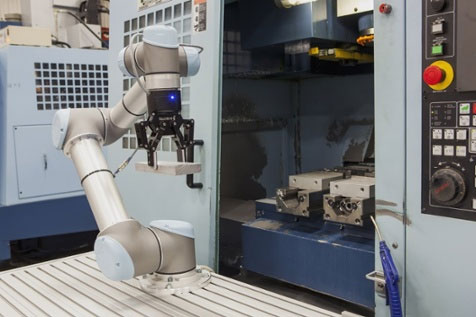Source: Robotics Industries Association
When bathing in a world where robots are a normal part of everyday life, I usually have a reality check when I am meeting customers or doing demos. The thing that I hear the most is: ”What can I do with this robot ?” It is then that I realize that the applications that can be done by robots are not well understood by most of the people that are looking for a robot. They want robots to automate tasks, but they don’t always know exactly what task. So here are some of the best applications that can be done by a collaborative robot (in my own opinion).
To simplify the hypothesis, we are usually working with the same robotic cell. A Universal Robots (mostly UR5) and a Robotiq Gripper (mostly 2-Finger 85). This cell is simple to install for a demo and can do a large number of tasks.

Machine Tending
From what I have observed, machine tending is a really good fit for this robotic cell. In fact, in small to medium sized machine shops, the parts will be slightly different one from the other and the ”high-mix / low-volume” factor is a real argument when it comes time to justify the robot. In fact, with the flexibility of a collaborative robot, you can relocate your robot in a couple of minutes and teach the new positions to the robot. Within 30 minutes your robot is relocated and good to go. Using flexible grippers like the 2-Finger 85 also requires very little programming time, while at the same time it can handle a very wide possibility of parts.
Machine Tending is often seen as tending a CNC machine with square or round metal parts. However, machine tending is broader than this. It in fact encompasses all types of machines that are ”tended”; CNC machines, plastic injection machines, PCB testing machines, CMM measuring machines and a lot more.
Packaging
There is big trend nowadays of using collaborative robots to do packaging. In fact, it is a redundant task that can be quite repetitive for a human worker. By putting a collaborative robot at this spot, you can still have workers around it and with minimal modifications, your robot can work like any other worker. With vision systems and adaptive Grippers, packaging tasks are now easier than ever.
We have recently release a Gripper (the 2-Finger 140) that is oriented towards packaging, consumer goods and fragile part handling applications. With a wide stroke (140 mm), adjustable force and other interesting features, it is the best Gripper for these tasks and fits pretty seamlessly on the Universal Robots. So seamlessly in fact that we have even put together a kit especially for UR.
Material Handling
It was kind of hard to put a lot of different applications in the same category, but I think material handling can be representative of a lot of different tasks. In fact, applications such as product testing, assembly, plus pick and place are all applications that are simply manipulating a part for another step in the manufacturing process. Since these processes are very wide, the use of flexible tooling is really important. A Gripper that can grasp a lot of different geometries, textures, and materials can be a game changer when you need to have a fast cycle time (you don’t want to be restricted to a tool changer every time). That being said, such applications can be seen in automotive and general industries where robots work alongside human workers and can use the same setup as if a human would work there. Once again the robot can be easily relocated and reprogrammed to do a wide variety of tasks.
Limitations
The important considerations for these robots are: payload, reach and precision.
For payload and reach, you can look at the UR10. Since usually if the part is heavier than 10 kg, it cannot be handled by ”one arm”, human or robot anyway, so an industrial robot would be necessary.
For precision, solutions are available to get better accuracy. Most of the time these robots will be placing parts in a given position with a 0.1 mm repeatability. If you can’t be off even by this amount then it makes sense to use Force -Torque Sensors to locate the fixture and place the part at the requested position. There are also situations where you can use custom fingertips to make sure the part is well aligned in the gripper. Once this is set, you can be sure your part will be positioned correctly.

